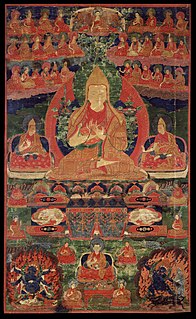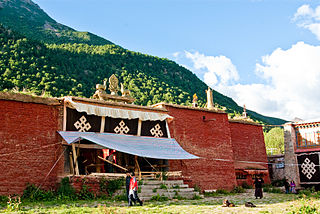Related Research Articles

Tibetan Buddhism is the form of Buddhism practiced in Tibet and Bhutan, where it is the dominant religion. It also has adherents in the regions surrounding the Himalayas, in much of Central Asia, in the Southern Siberian regions such as Tuva, and in Mongolia.

The Gelug is the newest of the four major schools of Tibetan Buddhism. It was founded by Je Tsongkhapa (1357–1419), a Tibetan philosopher, tantric yogi and lama and further expanded and developed by his disciples.

The Kagyu school, also transliterated as Kagyü, or Kagyud, which translates to "Oral Lineage" or "Whispered Transmission" school, is one of the main schools of Himalayan or Tibetan Buddhism. The Kagyu lineages trace themselves back to the 11th century Indian Mahasiddhas Naropa, Maitripa and the yogini Niguma, via their student Marpa Lotsawa (1012–1097), who brought their teachings to Tibet. Marpa's student Milarepa was also an influential poet and teacher.

The Kadam school of Tibetan Buddhism was an 11th century Buddhist tradition founded by the great Bengali master Atiśa (982-1054) and his students like Dromtön (1005–1064), a Tibetan Buddhist lay master. The Kadampa stressed compassion, pure discipline and study.

Atiśa Dīpankara Śrījñāna was a Buddhist religious leader and master. He is generally associated with his work carried out at the Vikramashila monastery in Bihar. He was one of the major figures in the spread of 11th-century Mahayana and Vajrayana Buddhism in Asia and inspired Buddhist thought from Tibet to Sumatra. He is recognised as one of the greatest figures of medieval Buddhism. Atiśa's chief disciple, Dromtön, was the founder of the Kadam school, one of the New Translation schools of Tibetan Buddhism, later supplanted by the Gelug tradition in the 14th century which adopted its teachings and absorbed its monasteries.

The Ganden Tripa, also spelled Gaden Tripa, is the title of the spiritual leader of the Gelug school of Tibetan Buddhism, the school that controlled central Tibet from the mid-17th century until the 1950s. The 103rd Ganden Tripa, Jetsun Lobsang Tenzin died in office on 21 April 2017. Jangtse Choejey Kyabje Jetsun Lobsang Tenzin Palsangpo is the current Ganden Tripa.

Geshe Kelsang Gyatso is a Buddhist monk, meditation teacher, scholar, and author. He is the founder and former spiritual director of the New Kadampa Tradition-International Kadampa Buddhist Union (NKT-IKBU), a registered non-profit, modern, sectarian and schismatic organization that came out of the Gelugpa school/lineage. 1,300 centres around the world, including temples, city temples and retreat centres offer an accessible approach to ancient wisdom.
Lamrim is a Tibetan Buddhist textual form for presenting the stages in the complete path to enlightenment as taught by Buddha. In Tibetan Buddhist history there have been many different versions of lamrim, presented by different teachers of the Nyingma, Kagyu and Gelug schools. However, all versions of the lamrim are elaborations of Atiśa's 11th-century root text A Lamp for the Path to Enlightenment (Bodhipathapradīpa).

The Rimé movement is a movement or tendency in Tibetan Buddhism which promotes non-sectarianism and universalism. Teachers from all branches of Tibetan Buddhism - Sakya, Kagyu, Nyingma, Jonang and Gelug, as well as Bon - have been involved in the promoting Rimé ideals.
The Dorje Shugden controversy is a controversy over Dorje Shugden, also known as Dolgyal, whom some consider to be one of several protectors of the Gelug school, the school of Tibetan Buddhism to which the Dalai Lamas belong. Dorje Shugden has become the symbolic focal point of a conflict over the "purity" of the Gelug school and the inclusion of non-Gelug teachings, especially Nyingma ones.

Dorje Shugden, also known as Dolgyal and Gyalchen Shugden, is an entity associated with the Gelug school, the newest of the schools of Tibetan Buddhism. Dorje Shugden is variously looked upon as a destroyed gyalpo, a minor mundane protector, a major mundane protector, an enlightened major protector whose outward appearance is that of a gyalpo, or as an enlightened major protector whose outward appearance is enlightened.

The New Kadampa Tradition – International Kadampa Buddhist Union (NKT—IKBU) is a global Buddhist new religious movement founded by Kelsang Gyatso in England in 1991. In 2003 the words "International Kadampa Buddhist Union" (IKBU) were added to the original name "New Kadampa Tradition". The NKT-IKBU is an international organisation registered in England as a charitable, or non-profit, company. It currently lists more than 200 centres and around 900 branch classes/study groups in 40 countries.
Geshe or geshema is a Tibetan Buddhist academic degree for monks and nuns. The degree is emphasized primarily by the Gelug lineage, but is also awarded in the Sakya and Bön traditions. The equivalent geshema degree is awarded to women.

Reting Monastery is an historically important Buddhist monastery in Lhünzhub County in Lhasa, Ü-Tsang, Tibet. It is also commonly spelled "Radreng."
Geshe Langri Thangpa (1054–1123) is an important figure in the lineage of the Kadampa and Gelug schools of Tibetan Buddhism. He was born in Phenpo, as Dorje Senge. His name derives from Langtang, the area in which he is said to have lived. He was a Kadampa master, and disciple of Potowa Rinchen Sel.
Tharpa Publications is a New York-based "major international and multilingual publisher of Buddhist books" by the Buddhist author and scholar Geshe Kelsang Gyatso. These include basic Buddhist meditation books such as The New Meditation Handbook, books on the Buddhist way of life such as Universal Compassion, books on Buddhist philosophy and psychology such as Heart of Wisdom, and books on Buddhist Tantra. Tharpa Publications is a non-profit corporation that has operated for 25 years and claims to have sold over a million books. Waterhouse adds that the books "are distributed widely and may be seen on the shelves of popular booksellers as well as in university libraries."

Lingshed Monastery or Lingshed Gompa is a Gelugpa Buddhist monastery in Ladakh, India. It is located near Lingshet village in the Leh district. It was founded in the 1440s by Changsems Sherabs Zangpo, disciple of Je Tsongkhapa, on a monastic site previously founded by the Translator Rinchen Zangpo. The monastery has belonged to the religious estate of Ngari Rinpoche since 1779. The Jangchub Tensung Dorje Center was founded in Lingshed by Kyabje Dagom Rinpoche in 1994.
Panchen Sonam Dragpa (1478–1554) was the fifteenth Ganden Tripa or throneholder of Ganden Monastery. His texts form the core curriculum for the Loseling College of Drepung Monastic University, the Shartse College of the Ganden Monastic University, and several other Gelugpa monasteries. He was taught by the second Dalai Lama, and in turn later became the teacher of the third Dalai Lama.
Rangtong and shentong are two distinctive views on emptiness (sunyata) and the two truths doctrine within Tibetan Buddhism.
Patsab Nyima Drakpa (1055-1145?) was a Tibetan Buddhist scholar and translator of the Sarma era. He was a monk at Sangpu monastery and traveled to Kashmir where he translated Buddhist Madhyamika texts.
References
- ↑ Das, Sarat Chandra (1902). A Tibetan—English Dictionary. Calcutta: The Bengal Secretariat Book Depot. pp. 63–64.
- ↑ Powers, John. "Gelukpa Tibetan Buddhism" entry in Melton, J. Gordon, and Martin Baumann. 2002. Religions of the World: A Comprehensive Encyclopedia of Beliefs and Practices. Santa Barbara, Calif: ABC-CLIO. p. 533.
- ↑ Samuel, Geoffrey. 1993. Civilized Shamans: Buddhism in Tibetan Societies. Washington DC: Smithsonian Institution Press.
- ↑ Bluck, R. (2006). British Buddhism: Teachings, practice and development. Routledge critical studies in Buddhism. London: Routledge. p. 129
- ↑ The Dorje Shugden Conflict: An Interview with Tibetologist Thierry Dodin, 8 May 2014. Retrieved 12 May 2014. "The NKT can be described typologically as a cult on the basis of its organisational form, its excessive group pressure and blind obedience to its founder."
- ↑ Mills, Martin (2003) Identity, Ritual and State in Tibetan Buddhism – The Foundations of Authority in Gelukpa Monasticism, p. 366, Routledge
- ↑ Kay, David N. (1997). "The New Kadampa Tradition and the Continuity of Tibetan Buddhism in Transition". Journal of Contemporary Religion. Routledge. 12 (3): 277–293. doi:10.1080/13537909708580806.